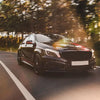The best features of the Ricoh Theta X
ProductThe Ricoh Theta X is an advanced 360-degree camera that stands out in the market for its high-quality images, user-friendly design, and a range of features that make capturing immersive stills and videos a breeze. In this article, we’ll explore some of the best features of the Ricoh Theta X, breaking down the technical terms into simple language, so whether you're a seasoned photographer or a beginner, you'll understand why this camera is a fantastic choice for creating stunning 360-degree content.
1. Large 2.25-Inch Touchscreen Display
One of the standout features of the Ricoh Theta X is its large 2.25-inch LCD touch panel. This is the first time the Theta series has included such a large display, making it significantly easier to use. With the touchscreen, you can quickly check the images and videos you’ve taken, right there on the spot. This feature saves time, as you no longer need to rely on a smartphone app to view or adjust settings. You can change detailed shooting settings directly on the camera, which is a massive boost in convenience, especially when you're on the go.

2. High-Resolution 60-Megapixel Images
The Ricoh Theta X boasts 60-megapixel image capability, achieved with dual image sensors allowing you to capture sharp, detailed, and vibrant 360-degree images. With a resolution of up to 11K (11008 x 5504 pixels), your photos will be crystal clear, with every tiny detail visible. This is perfect for anyone who needs high-quality images, such as real estate agents, virtual tour creators, or hobbyists who want the best possible picture quality.
3. 5.7K Video Recording with Enhanced Stabilization
For those interested in video, the Ricoh Theta X offers 5.7K video recording at 30 frames per second. This means your videos will look incredibly smooth and realistic, perfect for creating immersive experiences, especially in virtual reality (VR). The camera also includes improved digital image stabilization, which helps keep your footage steady even if you're moving. Whether you’re recording action scenes or simply walking while filming, the Theta X keeps your videos looking professional.
4. Expandable Memory and Replaceable Battery
Unlike many other cameras, the Ricoh Theta X supports external memory cards in addition to its internal storage. This means you can shoot for longer periods without worrying about running out of space. Moreover, the camera has a replaceable battery, which is a big plus for extended shoots. If you’re out all day or on a trip, just swap the battery, and you’re good to go—no need to stop and recharge. This feature makes the Theta X ideal for travel, events, and long-duration projects.
5. Built-In GPS for Accurate Location Data
The Theta X includes built-in GPS and A-GPS capabilities. This feature is especially useful if you want to add location data to your photos, making it easier to organize and remember where you took your shots. Accurate position information can be embedded directly into your 360-degree images, which is excellent for documenting travels or for professional uses, such as in real estate or construction. These GPS capabilities can also be managed through the Ricoh 360 app , allowing for easy access and integration of location data.
6. Slim, Durable, and High-End Design
Despite packing in so many features, the Ricoh Theta X maintains a slim and lightweight body. Made from magnesium alloy, the camera is both durable and has a premium feel. The compact design means it’s easy to carry around, fitting comfortably in your hand or pocket. Plus, the camera’s auto brightness adjustment function on the LCD ensures you can clearly see the display, even in bright outdoor conditions.

7. Easy Sharing and Editing with the THETA+ App
The Ricoh Theta X integrates seamlessly with the Ricoh 360 app, which is available for both smartphones and PCs. This app makes it incredibly easy to edit your 360-degree photos and videos, allowing you to add finishing touches and enhance your content before sharing it. Uploading your creations to social media platforms like Facebook, Instagram, and Twitter is straightforward, letting you showcase your 360-degree world with friends and followers.
8. Direct Upload to Cloud Services
Another convenient feature is the ability to link your Ricoh Theta X to various cloud services and solutions. This includes virtual tour services, making it easy for professionals to upload and share their work directly from the camera. This connectivity is a game-changer for those who need to quickly distribute their content to clients or online platforms.
9. Versatile Shooting Modes and Easy Controls
The Ricoh Theta X comes with various shooting modes, including standard photo, video, and interval shooting. It’s designed to be user-friendly, with controls that are easy to understand and operate, even for beginners. Whether you’re adjusting the exposure, switching between different photo modes, or simply snapping a quick picture, the intuitive interface ensures a smooth experience.
10. Excellent Battery Life
The Theta X offers approximately 220 photos on a full battery charge or up to 30 minutes of continuous video recording at 5.7K resolution. This robust battery life means you can capture plenty of content before needing to recharge. And because the battery is replaceable, you can carry extras with you for even longer sessions.
11. Seamless Wireless Transfer
With the Ricoh Theta X, transferring photos and videos to your smartphone is quick and easy thanks to high-speed wireless connectivity. This feature means you can review and share your content without having to deal with cables or complex setups. Simply connect wirelessly, and your images are ready to go.
Conclusion
The Ricoh Theta X stands out as one of the most advanced and user-friendly 360-degree cameras available. Its combination of a large touchscreen, high-resolution capabilities, versatile memory options, and ease of use make it a top choice for both beginners and professionals. Whether you’re capturing moments for personal enjoyment or professional use, the Theta X offers the tools and quality you need to create immersive, high-quality 360-degree images and videos. If you’re looking to step up your 360-degree photography game, the Ricoh Theta X is definitely worth considering.


